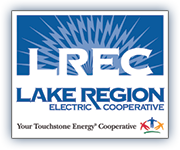History
Watch this video on YouTube. Download a PDF of the captions.
In 1935 President Roosevelt signed the Rural Electrification Act. This act enabled rural residents to form cooperatives and to bring much-needed electric service to rural America. Investor-owned utilities were not interested in bringing electricity to farms and rural residents because it was not profitable to serve them. The Rural Electrification Act provided Rural Electric Cooperatives (REC's) with low-interest government loans to build the lines and provide power to their members. The cooperatives are non-profit organizations and all surpluses after expenses and repayment of government debts are paid back to the members in the form of capital credits.
Lake Region Electric Cooperative, Inc. (LREC) was incorporated in 1949 when the members of East Central Electric Cooperative, located in Okmulgee, decided to divide its territory into two separate cooperatives in order to be able to provide better service to its members. A portion of East Central Electric Cooperative, east of the Arkansas River, which now surrounds Lake Fort Gibson and Lake Tenkiller, became Lake Region Electric Cooperative, Inc. LREC at its inception had 1,700 member-consumers and 116 employees. Today LREC has over 25,500 member-consumers and 106 employees.
In 1951 an average household used 75-kilowatt hours per month and an average electric (light) bill of $4.39. The cost of each kilowatt-hour was 5.8 cents. Today, an average household uses 1,200-kilowatt-hours and the average electric bill (not just the light bill) is $123, approximately 10.3 cents per kilowatt-hour. This adds up to less than 3/4 of one percent increase per year, which is far below the rate of inflation. The average cost of a new car has risen by about 20 percent a year in the past ten years.
In 1951 LREC had $1,819,000 in assets and owed REA $1,811,000 with almost no members equity. Today LREC's assets are $125 million with long-term debt of $48 million and members equity of $59 million.
Construction of the new LREC headquarters was completed in 1969 and LREC moved from Wagoner to its current location in Hulbert. LREC maintains two sub-offices in Tahlequah and Wagoner and currently serves portions of seven counties in northeast Oklahoma. Cherokee, Wagoner, Adair, Muskogee, Mayes, Rogers, and Delaware are among the counties served by LREC's more than 3,150 miles of lines.
LREC is a non-profit electric cooperative dedicated to providing power and opportunity to the areas it serves. Reliable electric power at a reasonable and affordable rate, economic development, and improving the infrastructure of its service area is among the goals of Lake Region Electric Cooperative, Inc.
Annually, margins are allocated back to the members as capital credits. In December of 2021, $1,364,269 was refunded to the members in the form of a credit on electric bills or a check. Capital credits are what sets a cooperative apart from its municipal or investor-owned counterparts (give the profits back to the members).
LREC has seven board members that are elected for a three-year term. They meet once a month to oversee the operations of the cooperative and set goals, policies, and procedures to ensure that the cooperative is operated with sound business practices. The operating and the capital budget of the cooperative are approved annually by the board of directors. The general manager, in turn, is responsible to the board and he makes sure that the cooperative is operated within the guidelines set by the board.
LREC members have enjoyed more than two decades of the lowest possible rates. LREC’s rates have continuously been ranked lower than average in Oklahoma and the nation.


